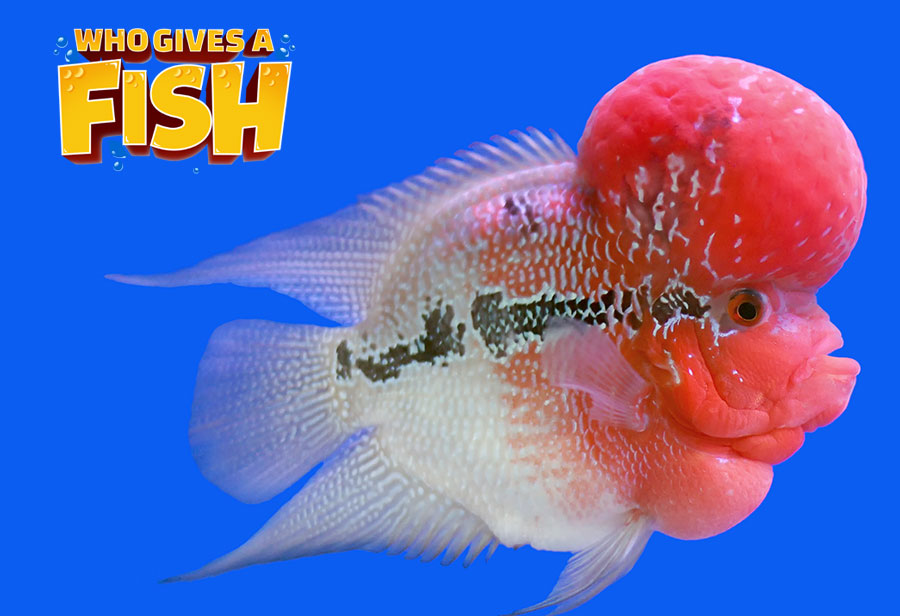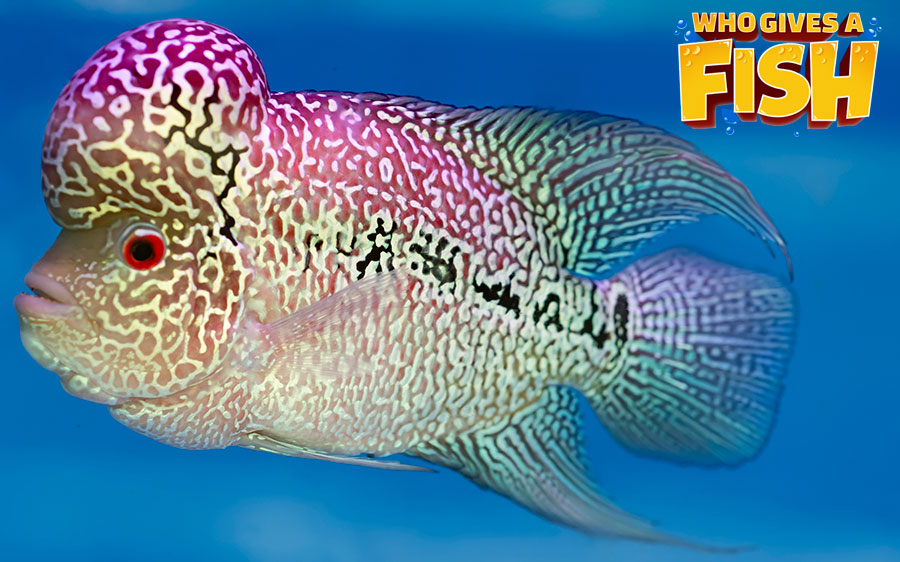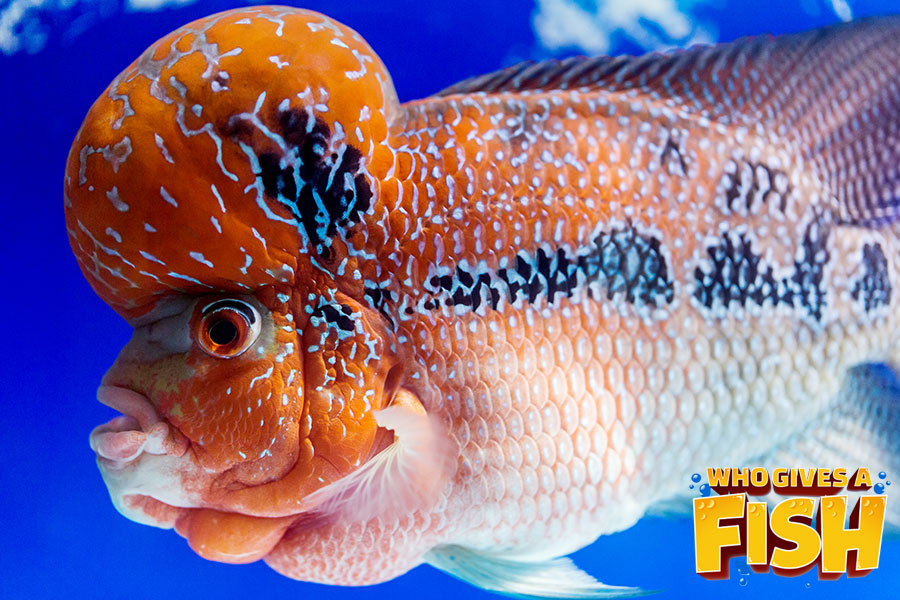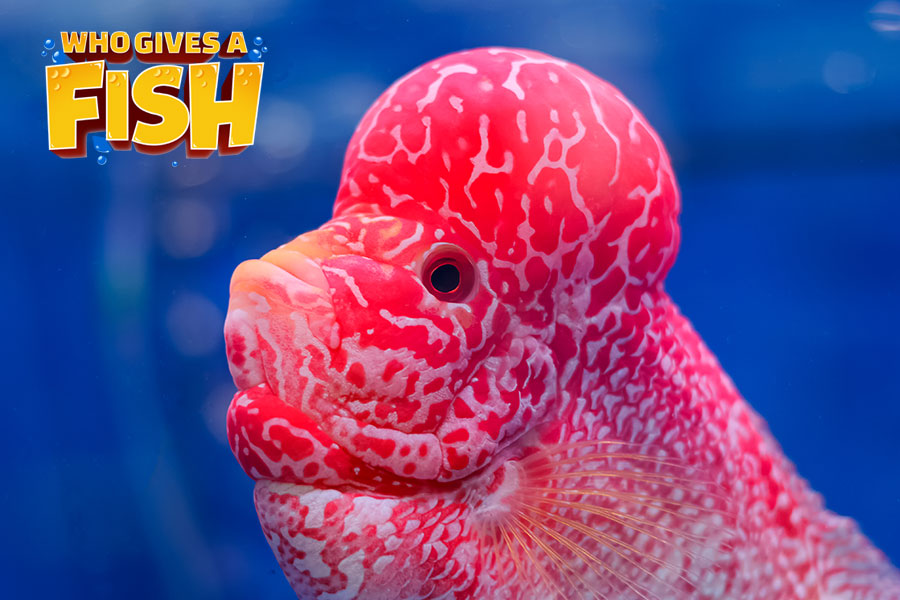Flowerhorn Cichlid
The Flowerhorn Cichlid is one of the most odd looking, yet prized Cichlids in the hobby. Various coloration is found throughout the world and the amount of hybrids internationally is staggering.
It is certainly one of the most interesting interbreeding that that has taken place within the hobby and some of these Cichlids fetch very large amounts of money. In certain Asian countries such as China and Vietnam, Flowerhorn Cichlids that display markings on their bodies that resemble Chinese characters can sell for thousands of dollars, depending on the meaning.
- Experience Level: Beginner
- Hardiness: Very Hardy
- Minimum Tank Size: 60 gal (230 L)
- Maximum Size: 16 in. (40.6 cm)
- Temperament: Very Aggressive – Predatory
- Temperature: 80.0 – 89° F (26.7 – 31.7° C)
- pH Range: 6.5 – 7.8
- Water Hardness: 9 – 20 dGH
- Diet: Carnivore
Table of Contents
Introduction
Aquarium Setup
Difficulty
Feeding
Breeding and Social
Just like the Blood Parrot Cichlid, the Flowerhorn Cichlid species is a cross-bred species not found naturally in the wild.
In Malaysia, there was a period of prolific interbreeding of Cichlids, and one of those produced was the Flowerhorn Cichlid. The meticulous attention to detail of the breeds and health of the combinations used were able to create a very hardy fish with amazing coloration and unique characteristics.
It is important to note that coloration and markings can and more often than not, will change as the fish develops into a fully mature adult. This often drives down the price of juvenile Flowerheads in fish stores and markets as the prized, expensive fish are mature and have already grown into their markings. Adult varieties can fetch thousands of dollars in Asian markets given unique Chinese characters that can develop on the fishes body, and such characters can have prosperous meanings.
While you can keep several Flowerhorn Cichlids in one tank, it needs to be a very big tank. These Cichlids are extremely territorial and highly aggressive. Any potential tankmates need to be carefully thought out and planned for, and closely monitored for signs of injury. Your Flowerhead will also bite you if given the chance, so take care of your fingers around larger specimens.
Aquarium Setup
This Cichlid demands plenty of room in its tank. A single fish requires at least 60 gallons and plenty of free swimming space. Any additional fish will require at least 150 gallons plus in order to curb aggression.
If you intend on breeding them then you should not place any other fish in the tank except for the breeding pair. Most other fish stand no chance to the constant barrage of attacks and harassment.
All rockwork and plants need to be securely anchored down as these Cichlids are not only adamant on moving things around the way the want them, but they are also very boisterous and can cause damage to the tank if rocks fall. Plants have little chance unless hardy specimens that are well secured into the substrate/rocks.
Gravel or sand as a substrate is fine, with some rocks for hiding spots, although most of the Flowerheads time will be spent swimming around the open areas of the tank (most likely patrolling and looking for a fight)
Flowerhorn Cichlid Aquarium Guide
- Minimum Tank Size: 60 gal (230 L)
- pH Range: 6.5 – 7.9
- Water Hardness: 9 – 20dGH
- Temperature: 80 – 89° F (26.7 – 31.7° C)
- Lighting: Moderate
- Substrate: Sand or Gravel.
- Brackish: No
- Water Flow: Low to Moderate.
- Tank Region: Mainly open areas.
Difficulty
The Flowerhead Cichlid is incredibly hardy and easy to look after. The only difficulty you will encounter is with other tankmates and your aquascaping. No less than excellent filtration is required for this big eater, especially as they become full sized adults.
While a beginner would be able to keep this fish alive, it’s likely to give them major headaches if trying to establish a community tank or one with a good amount of rocks and plants.
Flowerhorn Cichlids are extremely aggressive and territorial and are known to bite the fingers of their keepers. It’s an ideal fish to be kept in a tank on its own or as a pair only.
Feeding
This Cichlid is a carnivore and demands a lot of food. They will eat all types of live and frozen meaty foods.
As with all fish it is recommended to vary their diet and be sure to include Cichlid specific pellets. You can also feed them insects such as worms, crickets, spiders and many other creepy crawlies. They love them. Feeding products with spirulina will assist with coloration.
Feed a good amount several times per day and keep an eye on their condition as this fish is easy to underfeed. They have a very big appetite and as such, create a large bioload. Be careful when feeding larger specimens as they will bite you.
Flowerhorn Cichlid Feeding Guide
- Diet: Carnivore
- Frequency: 2 to 3 big meals per day.
- Pellet Foods: Yes, Cichlid specific pellets.
- Flake Foods: Only when very young, bigger fish need more food.
- Live Foods: Yes, other small fish, shrimp, worms and other insects.
- Meat Foods: Avoid hearts and livers for this Cichlid, but ensure plenty of meaty fish and insects are offered.
- Vegetable Foods: Sometime partly cooked dark leafy greens to compliment high quality Cichlid pellets.
Breeding
Adults have been noted to display a thick tube that sticks out from their vents during spawning time. There is many arguments regarding which sex has the bigger tube and/or vent, and at time of publication, it is still too difficult to accurately determine the sex of these Cichlids.
A rather cruel but commonly used method by South East Asian fish farmers is to take a younger fish in your hand and to press on its belly just below the ribs of the fish, towards the vent. If any clear liquids are released from the vent area then this is likely to be a male. Female fish will not produce any liquid when performing this check.
We don’t advise doing this to fish as it seems rather cruel and potentially painful, not to mention the stress you force on them.
Breeding the Flowerhorn is easy in that they have no reservation to spawning, it’s just that they are so aggressive, that they often kill other and their young during the process if your tank is not big enough. You should pay close attention to where your fish came from, and if possible, viewing as many generations of breeding pairs back as you can. This will help you ensure the types of color and markings you can expect.
The female will lay her eggs on a flat rock and the male will fertilize them. Careful attention to the female is required here as she will be weak and is often attacked by the aggressive male. The female and the eggs should be removed from the tank once fertilized for maximum survival rate of the young and indeed, the mother. If your tank has a divider, then this is best as it will not cause any stress on the female and the young.
Keep your water parameters around pH 7.0 and 82° F. Extra filtration is useful here in order to ensure the water is of excellent quality and keeping up with the additional bioload.
Feed the young fry with live brine shrimp and Cichlid specific Pellets and Flake foods that you need to crush into small pieces in order for the young to be able to fit them into their mouths.
Social
The Flowerhorn Cichlid is extremely aggressive and territorial. It is also predatory and will hunt down and eat other small fish.
In most cases, it is best to keep this fish alone or in a pair. Pairing the Flowerhead can be difficult and pairs are best pruchased from a reputable breeder who can easily supply you a breeding pair.
Trying to buy several of these fish in the hope that you will get a breeding pair, can and most likely will end in disaster. You may end up with a pair, but the others will take such a severe bullying that they will likely die and become food.





